MGMT19126 Assessment 2: Operations Management Report on McDonald's
VerifiedAdded on 2022/11/14
|13
|3228
|434
Report
AI Summary
This report provides an in-depth analysis of the operations management strategies for a new McDonald's store in Tharwa, Australia. It begins with an executive summary, followed by an introduction to McDonald's and a discussion of factors influencing site location and facility layout design, including market proximity, transportation, infrastructure, and labor. The report explores the pros and cons of different location decisions and layout options, particularly the product facility layout. It then applies Hill's Strategy Development Framework, examining corporate objectives, marketing strategies, and infrastructure needs. The report also offers recommendations for managing demand fluctuations and capacity constraints, concluding with an overall summary of the findings and a list of references.
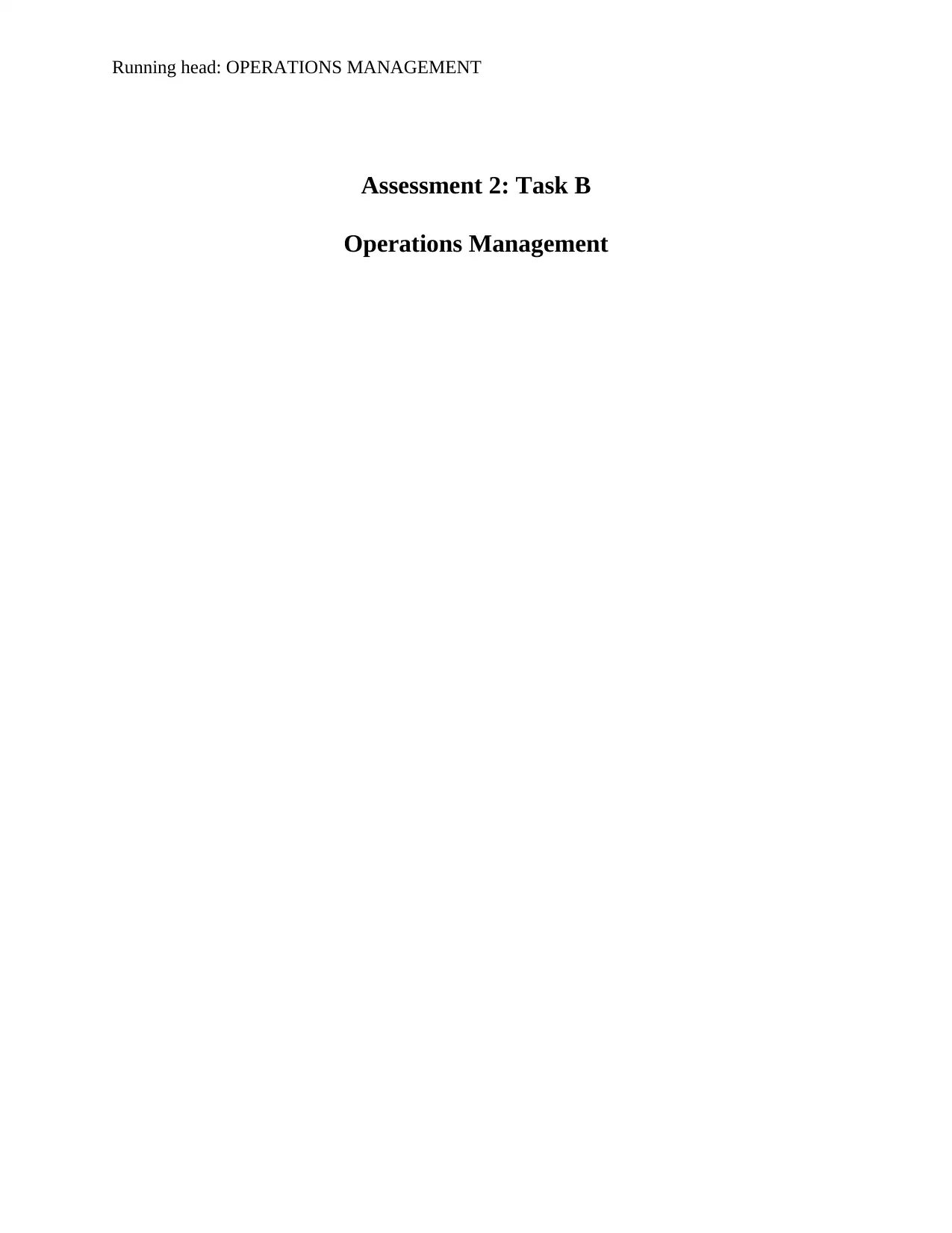
Running head: OPERATIONS MANAGEMENT
Assessment 2: Task B
Operations Management
Assessment 2: Task B
Operations Management
Paraphrase This Document
Need a fresh take? Get an instant paraphrase of this document with our AI Paraphraser
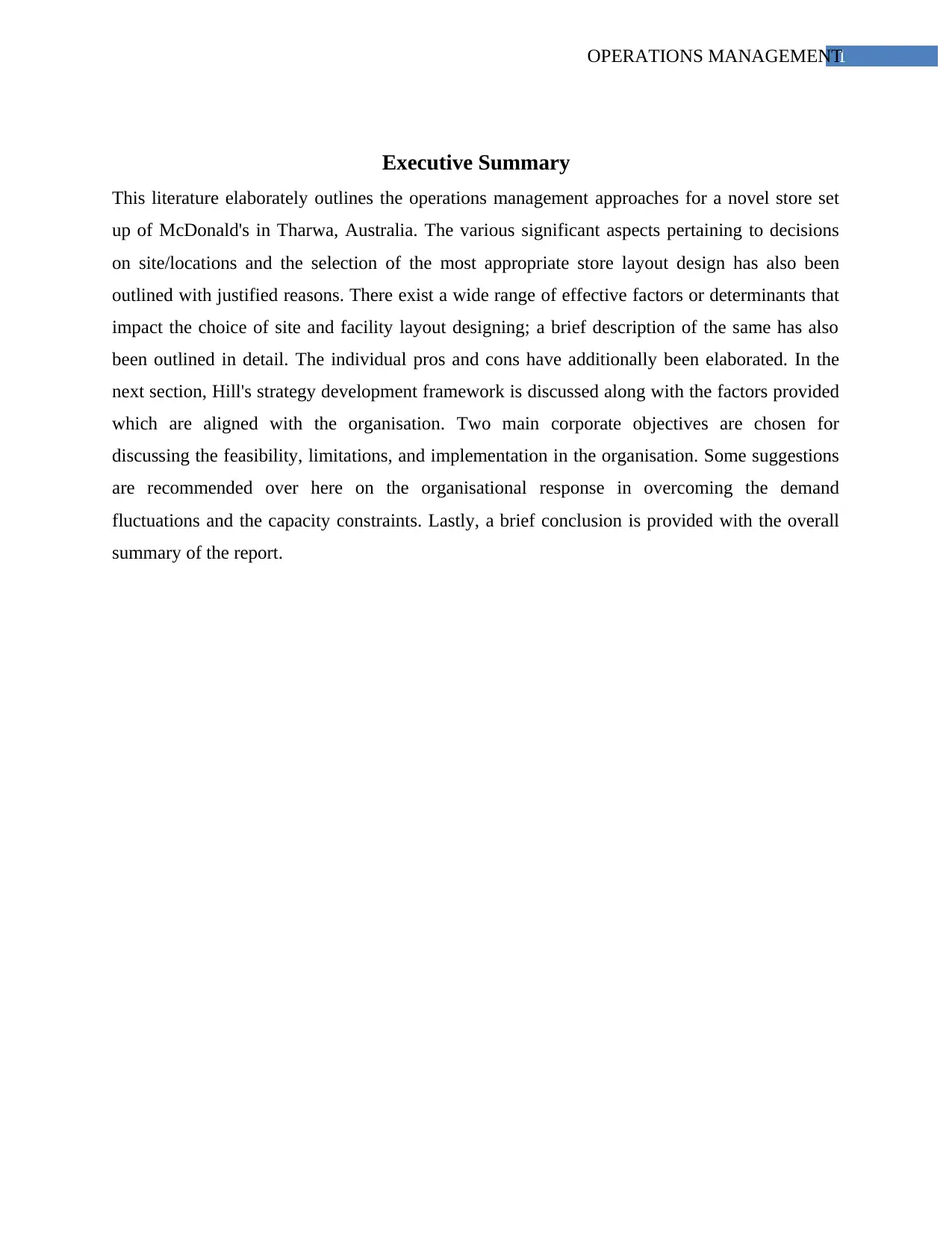
1OPERATIONS MANAGEMENT
Executive Summary
This literature elaborately outlines the operations management approaches for a novel store set
up of McDonald's in Tharwa, Australia. The various significant aspects pertaining to decisions
on site/locations and the selection of the most appropriate store layout design has also been
outlined with justified reasons. There exist a wide range of effective factors or determinants that
impact the choice of site and facility layout designing; a brief description of the same has also
been outlined in detail. The individual pros and cons have additionally been elaborated. In the
next section, Hill's strategy development framework is discussed along with the factors provided
which are aligned with the organisation. Two main corporate objectives are chosen for
discussing the feasibility, limitations, and implementation in the organisation. Some suggestions
are recommended over here on the organisational response in overcoming the demand
fluctuations and the capacity constraints. Lastly, a brief conclusion is provided with the overall
summary of the report.
Executive Summary
This literature elaborately outlines the operations management approaches for a novel store set
up of McDonald's in Tharwa, Australia. The various significant aspects pertaining to decisions
on site/locations and the selection of the most appropriate store layout design has also been
outlined with justified reasons. There exist a wide range of effective factors or determinants that
impact the choice of site and facility layout designing; a brief description of the same has also
been outlined in detail. The individual pros and cons have additionally been elaborated. In the
next section, Hill's strategy development framework is discussed along with the factors provided
which are aligned with the organisation. Two main corporate objectives are chosen for
discussing the feasibility, limitations, and implementation in the organisation. Some suggestions
are recommended over here on the organisational response in overcoming the demand
fluctuations and the capacity constraints. Lastly, a brief conclusion is provided with the overall
summary of the report.
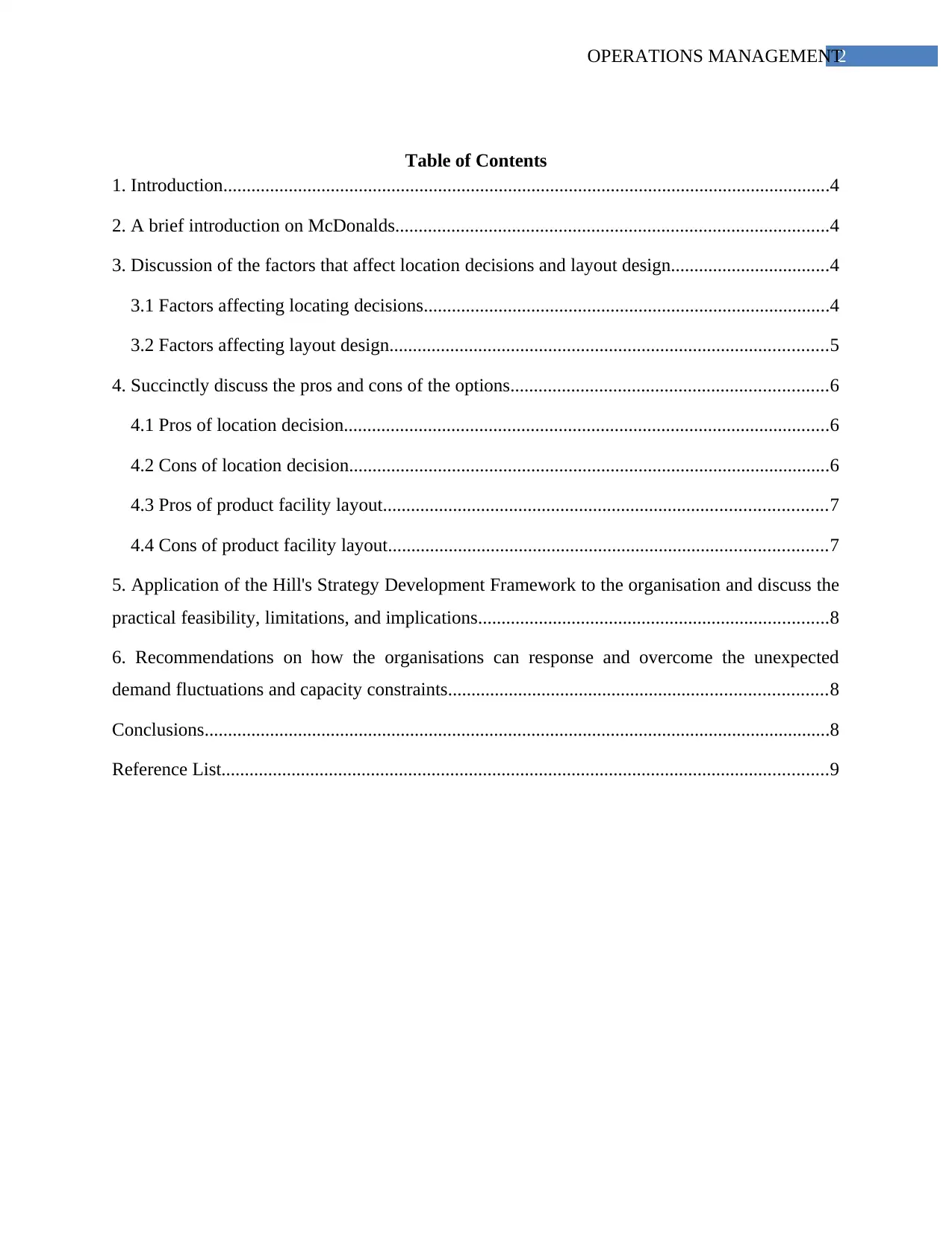
2OPERATIONS MANAGEMENT
Table of Contents
1. Introduction..................................................................................................................................4
2. A brief introduction on McDonalds.............................................................................................4
3. Discussion of the factors that affect location decisions and layout design..................................4
3.1 Factors affecting locating decisions.......................................................................................4
3.2 Factors affecting layout design..............................................................................................5
4. Succinctly discuss the pros and cons of the options....................................................................6
4.1 Pros of location decision........................................................................................................6
4.2 Cons of location decision.......................................................................................................6
4.3 Pros of product facility layout...............................................................................................7
4.4 Cons of product facility layout..............................................................................................7
5. Application of the Hill's Strategy Development Framework to the organisation and discuss the
practical feasibility, limitations, and implications...........................................................................8
6. Recommendations on how the organisations can response and overcome the unexpected
demand fluctuations and capacity constraints.................................................................................8
Conclusions......................................................................................................................................8
Reference List..................................................................................................................................9
Table of Contents
1. Introduction..................................................................................................................................4
2. A brief introduction on McDonalds.............................................................................................4
3. Discussion of the factors that affect location decisions and layout design..................................4
3.1 Factors affecting locating decisions.......................................................................................4
3.2 Factors affecting layout design..............................................................................................5
4. Succinctly discuss the pros and cons of the options....................................................................6
4.1 Pros of location decision........................................................................................................6
4.2 Cons of location decision.......................................................................................................6
4.3 Pros of product facility layout...............................................................................................7
4.4 Cons of product facility layout..............................................................................................7
5. Application of the Hill's Strategy Development Framework to the organisation and discuss the
practical feasibility, limitations, and implications...........................................................................8
6. Recommendations on how the organisations can response and overcome the unexpected
demand fluctuations and capacity constraints.................................................................................8
Conclusions......................................................................................................................................8
Reference List..................................................................................................................................9
⊘ This is a preview!⊘
Do you want full access?
Subscribe today to unlock all pages.

Trusted by 1+ million students worldwide
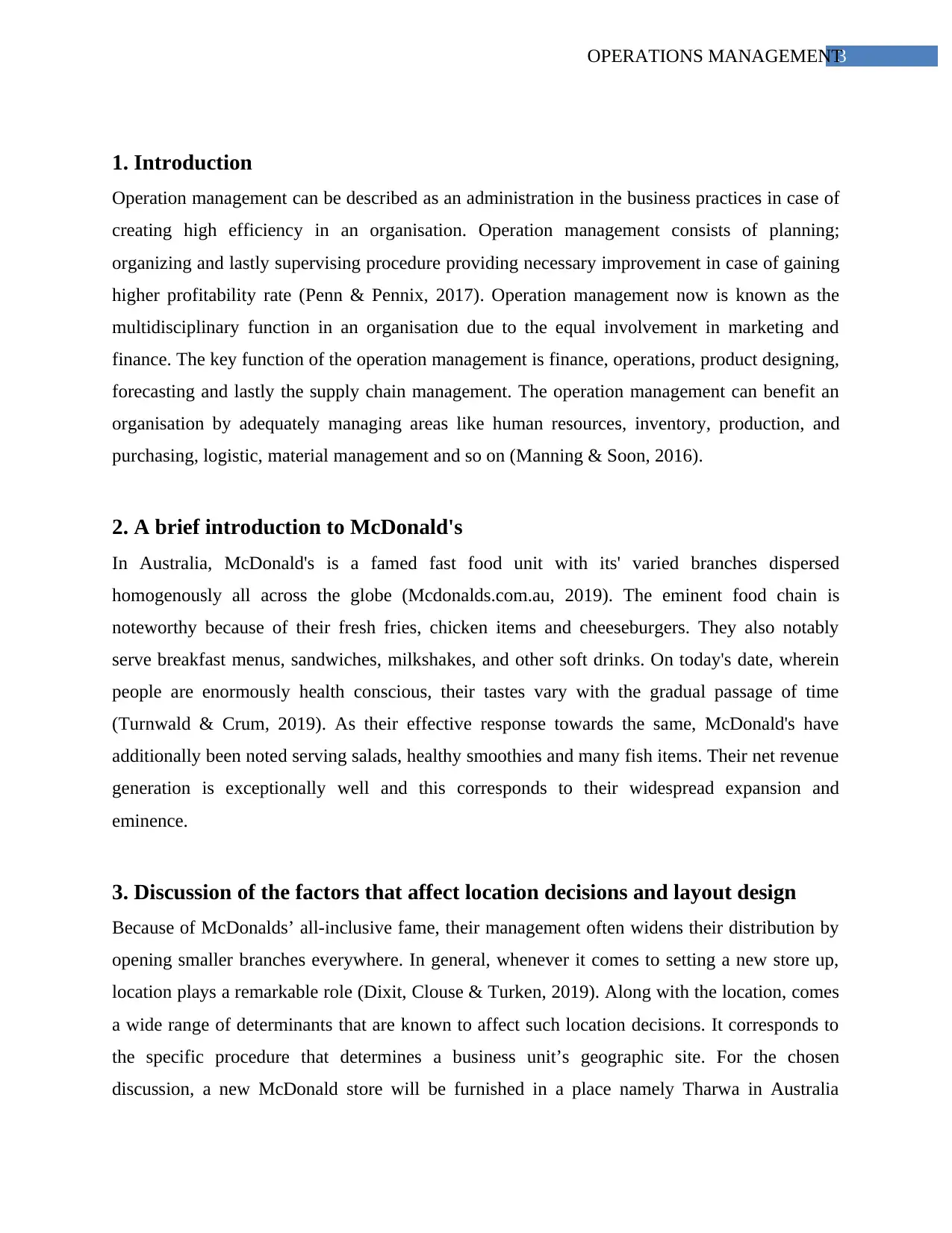
3OPERATIONS MANAGEMENT
1. Introduction
Operation management can be described as an administration in the business practices in case of
creating high efficiency in an organisation. Operation management consists of planning;
organizing and lastly supervising procedure providing necessary improvement in case of gaining
higher profitability rate (Penn & Pennix, 2017). Operation management now is known as the
multidisciplinary function in an organisation due to the equal involvement in marketing and
finance. The key function of the operation management is finance, operations, product designing,
forecasting and lastly the supply chain management. The operation management can benefit an
organisation by adequately managing areas like human resources, inventory, production, and
purchasing, logistic, material management and so on (Manning & Soon, 2016).
2. A brief introduction to McDonald's
In Australia, McDonald's is a famed fast food unit with its' varied branches dispersed
homogenously all across the globe (Mcdonalds.com.au, 2019). The eminent food chain is
noteworthy because of their fresh fries, chicken items and cheeseburgers. They also notably
serve breakfast menus, sandwiches, milkshakes, and other soft drinks. On today's date, wherein
people are enormously health conscious, their tastes vary with the gradual passage of time
(Turnwald & Crum, 2019). As their effective response towards the same, McDonald's have
additionally been noted serving salads, healthy smoothies and many fish items. Their net revenue
generation is exceptionally well and this corresponds to their widespread expansion and
eminence.
3. Discussion of the factors that affect location decisions and layout design
Because of McDonalds’ all-inclusive fame, their management often widens their distribution by
opening smaller branches everywhere. In general, whenever it comes to setting a new store up,
location plays a remarkable role (Dixit, Clouse & Turken, 2019). Along with the location, comes
a wide range of determinants that are known to affect such location decisions. It corresponds to
the specific procedure that determines a business unit’s geographic site. For the chosen
discussion, a new McDonald store will be furnished in a place namely Tharwa in Australia
1. Introduction
Operation management can be described as an administration in the business practices in case of
creating high efficiency in an organisation. Operation management consists of planning;
organizing and lastly supervising procedure providing necessary improvement in case of gaining
higher profitability rate (Penn & Pennix, 2017). Operation management now is known as the
multidisciplinary function in an organisation due to the equal involvement in marketing and
finance. The key function of the operation management is finance, operations, product designing,
forecasting and lastly the supply chain management. The operation management can benefit an
organisation by adequately managing areas like human resources, inventory, production, and
purchasing, logistic, material management and so on (Manning & Soon, 2016).
2. A brief introduction to McDonald's
In Australia, McDonald's is a famed fast food unit with its' varied branches dispersed
homogenously all across the globe (Mcdonalds.com.au, 2019). The eminent food chain is
noteworthy because of their fresh fries, chicken items and cheeseburgers. They also notably
serve breakfast menus, sandwiches, milkshakes, and other soft drinks. On today's date, wherein
people are enormously health conscious, their tastes vary with the gradual passage of time
(Turnwald & Crum, 2019). As their effective response towards the same, McDonald's have
additionally been noted serving salads, healthy smoothies and many fish items. Their net revenue
generation is exceptionally well and this corresponds to their widespread expansion and
eminence.
3. Discussion of the factors that affect location decisions and layout design
Because of McDonalds’ all-inclusive fame, their management often widens their distribution by
opening smaller branches everywhere. In general, whenever it comes to setting a new store up,
location plays a remarkable role (Dixit, Clouse & Turken, 2019). Along with the location, comes
a wide range of determinants that are known to affect such location decisions. It corresponds to
the specific procedure that determines a business unit’s geographic site. For the chosen
discussion, a new McDonald store will be furnished in a place namely Tharwa in Australia
Paraphrase This Document
Need a fresh take? Get an instant paraphrase of this document with our AI Paraphraser

4OPERATIONS MANAGEMENT
located a few kilometres from the Australian capital city. McDonald service managers invariably
should measure a few factors while determining the eligibility pertaining to a specific location
that even includes proximity, labour cost, the ready availability of consumers and transportation
cost (Venter de Villiers, Visnenza & Phiri, 2018).
3.1 Factors affecting locating decisions
Market proximity: Closeness to markets strongly ensures a regular and continuous supply of
varied essentials and also lessens transportation cost predominantly. Like every unit, McDonald's
also prefers serving their customers with the very best of their abilities and at the accurate time.
In this regard, it is solicited that McDonald's will choose an accessible location of Tharwa with
the local supermarket located close by.
Transportation facilities: It is preferred that McDonald's launch their store in such a busy area of
Tharwa which is characterized by proper transportation facilities. Speedy transportation is a
significant prerequisite for the same.
Infrastructure availability: Facilities including water system, power, and waste disposal are
three predominant factors that impact location decisions.
Labour: Availability of skilled labours is of utmost importance during plant location. Importing
labours welcome certain complexities including administrative issues. Prevailing wage system of
the available labours is eminent determinants to be considered (Richardson, de Leeuw &
Dullaert, 2016).
Facility layout design: Facility layout is a significant segment pertaining to any business whose
major objective corresponds to a steady workflow and information system (Tayal et al., 2017).
For McDonald’s proficient manufacturing, special emphasis on product facility layout must be
given. McDonald’s new layout inevitably needs to be spacious with the intent of providing
optimum space to enable easy and a comfortable work environment which generate flexibility.
This involves space utilization in their units and kiosks. McDonald’s must generate awareness
pertaining to safety standards including health hazards. They should also inculcate better workers
and also supervisors training to ensure uniformity in learning. They must invariably reduce
indirect administrative work so that their prime focus is on quality and service. Lastly, its net
capital investment needs to be minimal.
located a few kilometres from the Australian capital city. McDonald service managers invariably
should measure a few factors while determining the eligibility pertaining to a specific location
that even includes proximity, labour cost, the ready availability of consumers and transportation
cost (Venter de Villiers, Visnenza & Phiri, 2018).
3.1 Factors affecting locating decisions
Market proximity: Closeness to markets strongly ensures a regular and continuous supply of
varied essentials and also lessens transportation cost predominantly. Like every unit, McDonald's
also prefers serving their customers with the very best of their abilities and at the accurate time.
In this regard, it is solicited that McDonald's will choose an accessible location of Tharwa with
the local supermarket located close by.
Transportation facilities: It is preferred that McDonald's launch their store in such a busy area of
Tharwa which is characterized by proper transportation facilities. Speedy transportation is a
significant prerequisite for the same.
Infrastructure availability: Facilities including water system, power, and waste disposal are
three predominant factors that impact location decisions.
Labour: Availability of skilled labours is of utmost importance during plant location. Importing
labours welcome certain complexities including administrative issues. Prevailing wage system of
the available labours is eminent determinants to be considered (Richardson, de Leeuw &
Dullaert, 2016).
Facility layout design: Facility layout is a significant segment pertaining to any business whose
major objective corresponds to a steady workflow and information system (Tayal et al., 2017).
For McDonald’s proficient manufacturing, special emphasis on product facility layout must be
given. McDonald’s new layout inevitably needs to be spacious with the intent of providing
optimum space to enable easy and a comfortable work environment which generate flexibility.
This involves space utilization in their units and kiosks. McDonald’s must generate awareness
pertaining to safety standards including health hazards. They should also inculcate better workers
and also supervisors training to ensure uniformity in learning. They must invariably reduce
indirect administrative work so that their prime focus is on quality and service. Lastly, its net
capital investment needs to be minimal.
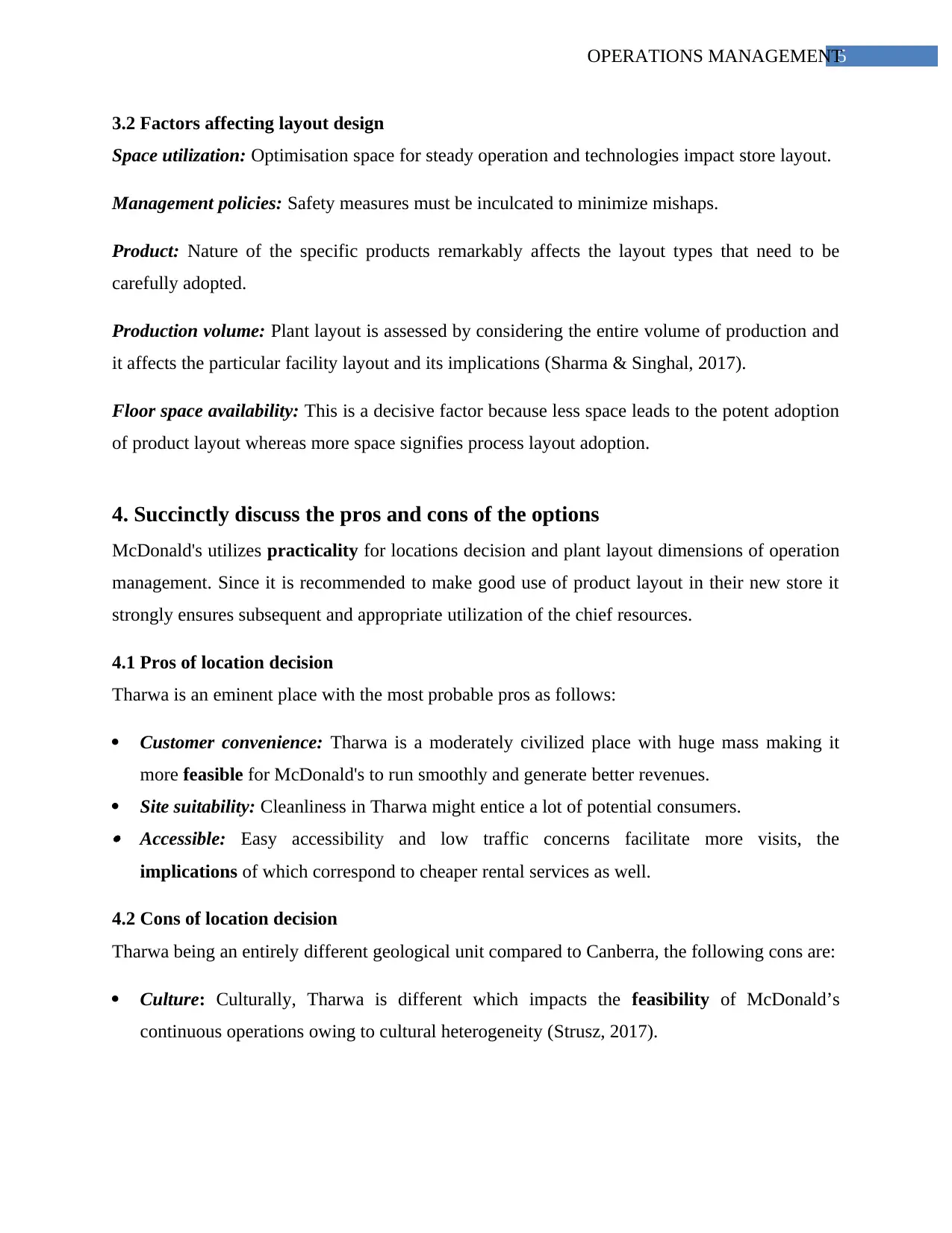
5OPERATIONS MANAGEMENT
3.2 Factors affecting layout design
Space utilization: Optimisation space for steady operation and technologies impact store layout.
Management policies: Safety measures must be inculcated to minimize mishaps.
Product: Nature of the specific products remarkably affects the layout types that need to be
carefully adopted.
Production volume: Plant layout is assessed by considering the entire volume of production and
it affects the particular facility layout and its implications (Sharma & Singhal, 2017).
Floor space availability: This is a decisive factor because less space leads to the potent adoption
of product layout whereas more space signifies process layout adoption.
4. Succinctly discuss the pros and cons of the options
McDonald's utilizes practicality for locations decision and plant layout dimensions of operation
management. Since it is recommended to make good use of product layout in their new store it
strongly ensures subsequent and appropriate utilization of the chief resources.
4.1 Pros of location decision
Tharwa is an eminent place with the most probable pros as follows:
Customer convenience: Tharwa is a moderately civilized place with huge mass making it
more feasible for McDonald's to run smoothly and generate better revenues.
Site suitability: Cleanliness in Tharwa might entice a lot of potential consumers. Accessible: Easy accessibility and low traffic concerns facilitate more visits, the
implications of which correspond to cheaper rental services as well.
4.2 Cons of location decision
Tharwa being an entirely different geological unit compared to Canberra, the following cons are:
Culture: Culturally, Tharwa is different which impacts the feasibility of McDonald’s
continuous operations owing to cultural heterogeneity (Strusz, 2017).
3.2 Factors affecting layout design
Space utilization: Optimisation space for steady operation and technologies impact store layout.
Management policies: Safety measures must be inculcated to minimize mishaps.
Product: Nature of the specific products remarkably affects the layout types that need to be
carefully adopted.
Production volume: Plant layout is assessed by considering the entire volume of production and
it affects the particular facility layout and its implications (Sharma & Singhal, 2017).
Floor space availability: This is a decisive factor because less space leads to the potent adoption
of product layout whereas more space signifies process layout adoption.
4. Succinctly discuss the pros and cons of the options
McDonald's utilizes practicality for locations decision and plant layout dimensions of operation
management. Since it is recommended to make good use of product layout in their new store it
strongly ensures subsequent and appropriate utilization of the chief resources.
4.1 Pros of location decision
Tharwa is an eminent place with the most probable pros as follows:
Customer convenience: Tharwa is a moderately civilized place with huge mass making it
more feasible for McDonald's to run smoothly and generate better revenues.
Site suitability: Cleanliness in Tharwa might entice a lot of potential consumers. Accessible: Easy accessibility and low traffic concerns facilitate more visits, the
implications of which correspond to cheaper rental services as well.
4.2 Cons of location decision
Tharwa being an entirely different geological unit compared to Canberra, the following cons are:
Culture: Culturally, Tharwa is different which impacts the feasibility of McDonald’s
continuous operations owing to cultural heterogeneity (Strusz, 2017).
⊘ This is a preview!⊘
Do you want full access?
Subscribe today to unlock all pages.

Trusted by 1+ million students worldwide
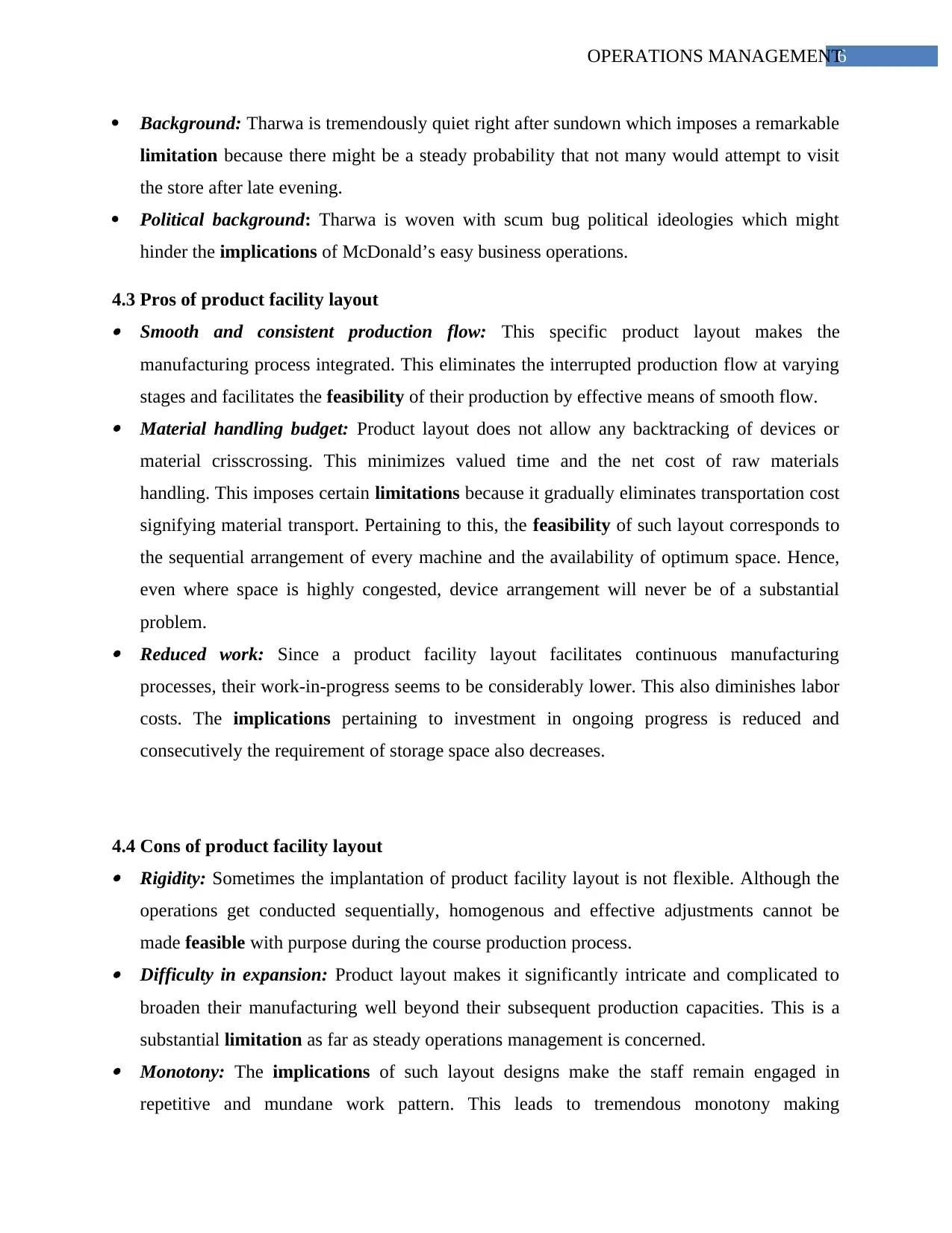
6OPERATIONS MANAGEMENT
Background: Tharwa is tremendously quiet right after sundown which imposes a remarkable
limitation because there might be a steady probability that not many would attempt to visit
the store after late evening.
Political background: Tharwa is woven with scum bug political ideologies which might
hinder the implications of McDonald’s easy business operations.
4.3 Pros of product facility layout Smooth and consistent production flow: This specific product layout makes the
manufacturing process integrated. This eliminates the interrupted production flow at varying
stages and facilitates the feasibility of their production by effective means of smooth flow. Material handling budget: Product layout does not allow any backtracking of devices or
material crisscrossing. This minimizes valued time and the net cost of raw materials
handling. This imposes certain limitations because it gradually eliminates transportation cost
signifying material transport. Pertaining to this, the feasibility of such layout corresponds to
the sequential arrangement of every machine and the availability of optimum space. Hence,
even where space is highly congested, device arrangement will never be of a substantial
problem. Reduced work: Since a product facility layout facilitates continuous manufacturing
processes, their work-in-progress seems to be considerably lower. This also diminishes labor
costs. The implications pertaining to investment in ongoing progress is reduced and
consecutively the requirement of storage space also decreases.
4.4 Cons of product facility layout Rigidity: Sometimes the implantation of product facility layout is not flexible. Although the
operations get conducted sequentially, homogenous and effective adjustments cannot be
made feasible with purpose during the course production process. Difficulty in expansion: Product layout makes it significantly intricate and complicated to
broaden their manufacturing well beyond their subsequent production capacities. This is a
substantial limitation as far as steady operations management is concerned. Monotony: The implications of such layout designs make the staff remain engaged in
repetitive and mundane work pattern. This leads to tremendous monotony making
Background: Tharwa is tremendously quiet right after sundown which imposes a remarkable
limitation because there might be a steady probability that not many would attempt to visit
the store after late evening.
Political background: Tharwa is woven with scum bug political ideologies which might
hinder the implications of McDonald’s easy business operations.
4.3 Pros of product facility layout Smooth and consistent production flow: This specific product layout makes the
manufacturing process integrated. This eliminates the interrupted production flow at varying
stages and facilitates the feasibility of their production by effective means of smooth flow. Material handling budget: Product layout does not allow any backtracking of devices or
material crisscrossing. This minimizes valued time and the net cost of raw materials
handling. This imposes certain limitations because it gradually eliminates transportation cost
signifying material transport. Pertaining to this, the feasibility of such layout corresponds to
the sequential arrangement of every machine and the availability of optimum space. Hence,
even where space is highly congested, device arrangement will never be of a substantial
problem. Reduced work: Since a product facility layout facilitates continuous manufacturing
processes, their work-in-progress seems to be considerably lower. This also diminishes labor
costs. The implications pertaining to investment in ongoing progress is reduced and
consecutively the requirement of storage space also decreases.
4.4 Cons of product facility layout Rigidity: Sometimes the implantation of product facility layout is not flexible. Although the
operations get conducted sequentially, homogenous and effective adjustments cannot be
made feasible with purpose during the course production process. Difficulty in expansion: Product layout makes it significantly intricate and complicated to
broaden their manufacturing well beyond their subsequent production capacities. This is a
substantial limitation as far as steady operations management is concerned. Monotony: The implications of such layout designs make the staff remain engaged in
repetitive and mundane work pattern. This leads to tremendous monotony making
Paraphrase This Document
Need a fresh take? Get an instant paraphrase of this document with our AI Paraphraser

7OPERATIONS MANAGEMENT
McDonald's staff practically lose interest from a job where the feasibility bears very less
opportunity for talent exhibition.
5. Application of the Hill's Strategy Development Framework to the
organisation and discuss the practical feasibility, limitations, and implications
This above mentioned Hill's strategy development framework is considered as the useful one in
case of strategy development which links the corporate objectives. The organisational directions,
as well as the marketing strategy, talk about the organisation's competition in the chosen market
along with the capability of completion. It is required to establish the operations which
organisation contributes in case of harnessing the competitive advantage. This framework is
incorporated with critical elements in order to make an effective and efficient operation process
in case of choice designing and infrastructure building. The strategy framework is incorporated
with 5 factors which are defining corporate objectives, determining the marketing strategies,
assessment of winning f different products in the market, the establishment of appropriate mode
and lastly providing the required infrastructure (Hesping & Schiele, 2015).
The strategy development framework can be understood by the table format as follows.
Operation’s strategy
Corporate
objectives
Marketing
Strategies
Order winners
and
qualifications
Infrastructure The design
choice of
operation
Profitable
growth
The McDonald’s
restaurant has 1300
worldwide stores
along with 150
new partner brand
restaurants which
are used in the
company’s
franchised stores.
The
competitive
priorities of the
company link
the marketing
and corporate
strategies in
case of making
operational
For this hiring
process and
criteria are
needed. Job
training and as
well as rewards
and recognition
is needed.
Training is
For this
corporate
objective flow,
shop process is
required along
with
standardized
store designing.
The jobs need to
McDonald's staff practically lose interest from a job where the feasibility bears very less
opportunity for talent exhibition.
5. Application of the Hill's Strategy Development Framework to the
organisation and discuss the practical feasibility, limitations, and implications
This above mentioned Hill's strategy development framework is considered as the useful one in
case of strategy development which links the corporate objectives. The organisational directions,
as well as the marketing strategy, talk about the organisation's competition in the chosen market
along with the capability of completion. It is required to establish the operations which
organisation contributes in case of harnessing the competitive advantage. This framework is
incorporated with critical elements in order to make an effective and efficient operation process
in case of choice designing and infrastructure building. The strategy framework is incorporated
with 5 factors which are defining corporate objectives, determining the marketing strategies,
assessment of winning f different products in the market, the establishment of appropriate mode
and lastly providing the required infrastructure (Hesping & Schiele, 2015).
The strategy development framework can be understood by the table format as follows.
Operation’s strategy
Corporate
objectives
Marketing
Strategies
Order winners
and
qualifications
Infrastructure The design
choice of
operation
Profitable
growth
The McDonald’s
restaurant has 1300
worldwide stores
along with 150
new partner brand
restaurants which
are used in the
company’s
franchised stores.
The
competitive
priorities of the
company link
the marketing
and corporate
strategies in
case of making
operational
For this hiring
process and
criteria are
needed. Job
training and as
well as rewards
and recognition
is needed.
Training is
For this
corporate
objective flow,
shop process is
required along
with
standardized
store designing.
The jobs need to

8OPERATIONS MANAGEMENT
strategies
(Hesping &
Schiele, 2015).
required for
unexpected ones.
Managing
department
needs to train the
employees.
Coaching as well
as counseling is
also required for
the employees.
be allocated
according to the
order taking
procedures. The
facility size and
capacity need t to
be checked.
Operational
excellence
The marketing
strategy should be
the ideal location
of stores, good
training programs
as well as staff
wellbeing
programs.
Low
price
High
service
quality
Quick
delivery
program
For this
objective control
systems and
operating plans
are required
ornamented with
shift
management and
equipment
maintenance.
The distribution
center also needs
to be considered.
To success this
strategy global
chain
coordination is
appropriate.
There should be
resource
scheduling as
well as
operational and
standardized job
process.
Diversity Long term
commitment in
case of diverse
work culture
Flexibili
ty
demand
For this strategy
innovation and
learning, the
system needs to
be considered.
For succussing
this
Strategy training
and franchising
are required
along with the
process
performance.
strategies
(Hesping &
Schiele, 2015).
required for
unexpected ones.
Managing
department
needs to train the
employees.
Coaching as well
as counseling is
also required for
the employees.
be allocated
according to the
order taking
procedures. The
facility size and
capacity need t to
be checked.
Operational
excellence
The marketing
strategy should be
the ideal location
of stores, good
training programs
as well as staff
wellbeing
programs.
Low
price
High
service
quality
Quick
delivery
program
For this
objective control
systems and
operating plans
are required
ornamented with
shift
management and
equipment
maintenance.
The distribution
center also needs
to be considered.
To success this
strategy global
chain
coordination is
appropriate.
There should be
resource
scheduling as
well as
operational and
standardized job
process.
Diversity Long term
commitment in
case of diverse
work culture
Flexibili
ty
demand
For this strategy
innovation and
learning, the
system needs to
be considered.
For succussing
this
Strategy training
and franchising
are required
along with the
process
performance.
⊘ This is a preview!⊘
Do you want full access?
Subscribe today to unlock all pages.

Trusted by 1+ million students worldwide
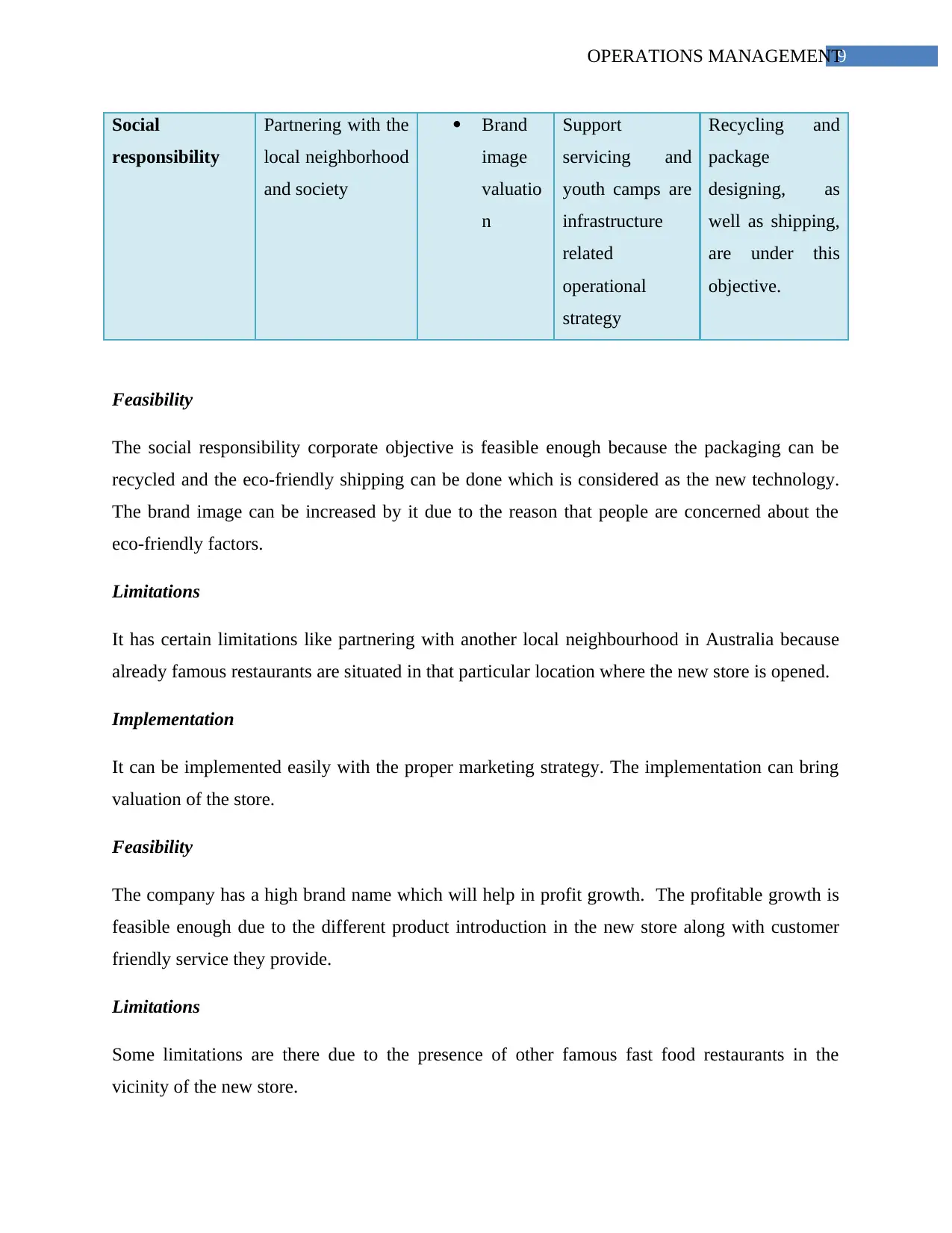
9OPERATIONS MANAGEMENT
Social
responsibility
Partnering with the
local neighborhood
and society
Brand
image
valuatio
n
Support
servicing and
youth camps are
infrastructure
related
operational
strategy
Recycling and
package
designing, as
well as shipping,
are under this
objective.
Feasibility
The social responsibility corporate objective is feasible enough because the packaging can be
recycled and the eco-friendly shipping can be done which is considered as the new technology.
The brand image can be increased by it due to the reason that people are concerned about the
eco-friendly factors.
Limitations
It has certain limitations like partnering with another local neighbourhood in Australia because
already famous restaurants are situated in that particular location where the new store is opened.
Implementation
It can be implemented easily with the proper marketing strategy. The implementation can bring
valuation of the store.
Feasibility
The company has a high brand name which will help in profit growth. The profitable growth is
feasible enough due to the different product introduction in the new store along with customer
friendly service they provide.
Limitations
Some limitations are there due to the presence of other famous fast food restaurants in the
vicinity of the new store.
Social
responsibility
Partnering with the
local neighborhood
and society
Brand
image
valuatio
n
Support
servicing and
youth camps are
infrastructure
related
operational
strategy
Recycling and
package
designing, as
well as shipping,
are under this
objective.
Feasibility
The social responsibility corporate objective is feasible enough because the packaging can be
recycled and the eco-friendly shipping can be done which is considered as the new technology.
The brand image can be increased by it due to the reason that people are concerned about the
eco-friendly factors.
Limitations
It has certain limitations like partnering with another local neighbourhood in Australia because
already famous restaurants are situated in that particular location where the new store is opened.
Implementation
It can be implemented easily with the proper marketing strategy. The implementation can bring
valuation of the store.
Feasibility
The company has a high brand name which will help in profit growth. The profitable growth is
feasible enough due to the different product introduction in the new store along with customer
friendly service they provide.
Limitations
Some limitations are there due to the presence of other famous fast food restaurants in the
vicinity of the new store.
Paraphrase This Document
Need a fresh take? Get an instant paraphrase of this document with our AI Paraphraser

10OPERATIONS MANAGEMENT
Implementation
For-profit growth, the store need to provide some good customer service along with fresh food.
For this, employees need to be given proper training.
6. Recommendations on how the organisations can response and overcome the
unexpected demand fluctuations and capacity constraints
The historical data need to be analysed for identifying the issues which affect the
replenishment of the perennial services of the whole year and use the information for
setting minimum stock level.
The software can help in managing back end operations which include inventory tracking
response replenishment and smart order management.
The inventory cost needs to be minimized in case of supporting the restaurant
management.
The capacity constraints will possibly be reduced with the help of hiring more contracted
workers but it needs to be kept in mind that the level of workforce needs to be adjusted.
Conclusions
The operation management needs to be taken into account for the balancing of the cot as well as
the quality of services and products of an organisation. A significant amount of analysis, as well
as planning, is required for the support of potential location and the long term strategy of the
McDonald. The above report has shed light on the new store opening along with the specific
location and eligibility pertaining in case of proximity, availability, labour cost and lastly
transportation cost. The factors are briefly discussed which can affect the layout designing and
the locational decision. Hill's strategy of development of the McDonald has been briefly
discussed along with some suggestion regarding the unexpected demand for capacity constraints
and fluctuations.
Implementation
For-profit growth, the store need to provide some good customer service along with fresh food.
For this, employees need to be given proper training.
6. Recommendations on how the organisations can response and overcome the
unexpected demand fluctuations and capacity constraints
The historical data need to be analysed for identifying the issues which affect the
replenishment of the perennial services of the whole year and use the information for
setting minimum stock level.
The software can help in managing back end operations which include inventory tracking
response replenishment and smart order management.
The inventory cost needs to be minimized in case of supporting the restaurant
management.
The capacity constraints will possibly be reduced with the help of hiring more contracted
workers but it needs to be kept in mind that the level of workforce needs to be adjusted.
Conclusions
The operation management needs to be taken into account for the balancing of the cot as well as
the quality of services and products of an organisation. A significant amount of analysis, as well
as planning, is required for the support of potential location and the long term strategy of the
McDonald. The above report has shed light on the new store opening along with the specific
location and eligibility pertaining in case of proximity, availability, labour cost and lastly
transportation cost. The factors are briefly discussed which can affect the layout designing and
the locational decision. Hill's strategy of development of the McDonald has been briefly
discussed along with some suggestion regarding the unexpected demand for capacity constraints
and fluctuations.

11OPERATIONS MANAGEMENT
Reference List
Boyle, G. (2017). Design project management. Routledge.
Dixit, A., Clouse, C., & Turken, N. (2019). Strategic Business Location Decisions: Importance
of Economic Factors and Place Image. Rutgers Business Review, 4(1).
Helmrich, M. J. R., Jans, R., van den Heuvel, W., & Wagelmans, A. P. (2015). The economic
lot-sizing problem with an emission capacity constraint. European Journal of
Operational Research, 241(1), 50-62.
Hesping, F. H., & Schiele, H. (2015). Purchasing strategy development: A multi-level
review. Journal of purchasing and supply management, 21(2), 138-150.
Manning, L., & Soon, J. M. (2016). Building strategic resilience in the food supply chain. British
Food Journal, 118(6), 1477-1493.
Mcdonalds.com.au (2019). About McDonald's. Retrieved from: https://mcdonalds.com.au/.
Penn, I. A., & Pennix, G. B. (2017). Records management handbook. Routledge.
Richardson, D. A., de Leeuw, S., & Dullaert, W. (2016). Factors affecting global inventory
prepositioning locations in humanitarian operations—a Delphi study. Journal of Business
Logistics, 37(1), 59-74.
Sharma, P., & Singhal, S. (2017). Implementation of fuzzy TOPSIS methodology in the selection
of procedural approach for facility layout planning. The International Journal of
Advanced Manufacturing Technology, 88(5-8), 1485-1493.
Strusz, D. L. (2017, December). Silurian brachiopods from the breadbox area north of Cooma,
New South Wales, Australia. In Proceedings of the Linnean Society of New South Wales
(Vol. 139).
Tang, S. Y., Mo, J. T., & Liu, T. Y. (2016). The Coordination of Supply Chain with Random
Fluctuation Price and Price-Dependent Demand. In Proceedings of the 22nd
International Conference on Industrial Engineering and Engineering Management
2015 (pp. 435-447). Atlantis Press, Paris.
Reference List
Boyle, G. (2017). Design project management. Routledge.
Dixit, A., Clouse, C., & Turken, N. (2019). Strategic Business Location Decisions: Importance
of Economic Factors and Place Image. Rutgers Business Review, 4(1).
Helmrich, M. J. R., Jans, R., van den Heuvel, W., & Wagelmans, A. P. (2015). The economic
lot-sizing problem with an emission capacity constraint. European Journal of
Operational Research, 241(1), 50-62.
Hesping, F. H., & Schiele, H. (2015). Purchasing strategy development: A multi-level
review. Journal of purchasing and supply management, 21(2), 138-150.
Manning, L., & Soon, J. M. (2016). Building strategic resilience in the food supply chain. British
Food Journal, 118(6), 1477-1493.
Mcdonalds.com.au (2019). About McDonald's. Retrieved from: https://mcdonalds.com.au/.
Penn, I. A., & Pennix, G. B. (2017). Records management handbook. Routledge.
Richardson, D. A., de Leeuw, S., & Dullaert, W. (2016). Factors affecting global inventory
prepositioning locations in humanitarian operations—a Delphi study. Journal of Business
Logistics, 37(1), 59-74.
Sharma, P., & Singhal, S. (2017). Implementation of fuzzy TOPSIS methodology in the selection
of procedural approach for facility layout planning. The International Journal of
Advanced Manufacturing Technology, 88(5-8), 1485-1493.
Strusz, D. L. (2017, December). Silurian brachiopods from the breadbox area north of Cooma,
New South Wales, Australia. In Proceedings of the Linnean Society of New South Wales
(Vol. 139).
Tang, S. Y., Mo, J. T., & Liu, T. Y. (2016). The Coordination of Supply Chain with Random
Fluctuation Price and Price-Dependent Demand. In Proceedings of the 22nd
International Conference on Industrial Engineering and Engineering Management
2015 (pp. 435-447). Atlantis Press, Paris.
⊘ This is a preview!⊘
Do you want full access?
Subscribe today to unlock all pages.

Trusted by 1+ million students worldwide
1 out of 13
Your All-in-One AI-Powered Toolkit for Academic Success.
+13062052269
info@desklib.com
Available 24*7 on WhatsApp / Email
![[object Object]](/_next/static/media/star-bottom.7253800d.svg)
Unlock your academic potential
Copyright © 2020–2025 A2Z Services. All Rights Reserved. Developed and managed by ZUCOL.
